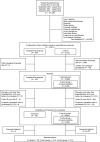Long-term effectiveness of a disease management program to prevent diabetic nephropathy: a propensity score matching analysis using administrative data in Japan
- PMID: 35596152
- PMCID: PMC9123750
- DOI: 10.1186/s12902-022-01040-4
Long-term effectiveness of a disease management program to prevent diabetic nephropathy: a propensity score matching analysis using administrative data in Japan
Abstract
Background: Existing reviews indicated that disease management for patients with diabetes may be effective in achieving better health outcomes with less resource utilization in the short term. However, the long-term results were inconsistent because of the heterogeneous nature of the study designs. In the present study, we evaluated the 5-year follow-up results of a local disease management program focused on diabetic nephropathy prevention under the universal public health insurance scheme in Japan.
Methods: Patients diagnosed with type 2 diabetes who had stage 3 or 4 diabetic kidney disease and were aged between 20 and 75 years were invited to join a disease management program to support self-management and receive a recommended treatment protocol between 2011 and 2013. Follow-up data were collected from an electronic claims database for the public insurance scheme. Considering the non-random selection process, we prepared two control groups matched by estimated propensity scores to compare the incidence of diabetes-related complications, death, and resource utilization.
Results: The treatment group was more likely to receive clinical management in accordance with the guideline-recommended medication. After propensity score matching, the treatment group had lower incidence of diabetic nephropathy and emergency care use than the control group selected from a beneficiary pool mainly under primary care. Comparisons between the treatment group and the control group with more selected clinical conditions did not show differences in the incidence rate and resource utilization.
Conclusions: The present results demonstrated limited effectiveness of the program for reducing complication incidence and resource utilization during the 5-year follow-up. Further research on the long-term effectiveness of co-management by primary care physicians, subspecialists in endocrinology and nephrology, and nurse educators is required for effective management of diabetes-related nephropathy.
Keywords: Diabetic nephropathy; Disease management; Electronic claims database; Health outcomes; Self-management.
© 2022. The Author(s).
Conflict of interest statement
The self-management program evaluated in the current study was provided by DPP Health Partners, Co. Ltd. under the contraction with Kure City authority, invested by Data Horizon, Co. Ltd., RCC Broadcasting, Co. Ltd., and MM when started. The original version of the program was developed by KK and MM as a part of thesis research of KK. The program was afterward adopted and modified by DPP Health Partners, Co. Ltd. MM was a non-corporate executive officer for the company between December 2010 and October 2018, supporting the in-house training for staff nurses unrelated to the self-management implementation, with stock share that was declared and approved by Hiroshima University authority for conflict-of-interests management. Since November 2018, MM abandoned the stock share, and has no conflict of interests with the company. The anonymized data used in the current study was provided by Kure City National Health Insurance authority for independent evaluation of the program effectiveness. Otherwise, authors have no conflict of interests to be declared.
Figures
Similar articles
-
The effect of continuity of care on the incidence of end-stage renal disease in patients with newly detected type 2 diabetic nephropathy: a retrospective cohort study.BMC Nephrol. 2018 Jun 5;19(1):127. doi: 10.1186/s12882-018-0932-3. BMC Nephrol. 2018. PMID: 29871604 Free PMC article.
-
Evaluation of a program designed to prevent diabetic nephropathy aggravation: A retrospective cohort study using health checkups and claims data in Japanese municipalities.Diabetes Res Clin Pract. 2024 Sep;215:111804. doi: 10.1016/j.diabres.2024.111804. Epub 2024 Jul 30. Diabetes Res Clin Pract. 2024. PMID: 39084292
-
Status of screening and preventive efforts against diabetic kidney disease between 2013 and 2018: analysis using an administrative database from Kyoto-city, Japan.Front Endocrinol (Lausanne). 2023 Jul 27;14:1195167. doi: 10.3389/fendo.2023.1195167. eCollection 2023. Front Endocrinol (Lausanne). 2023. PMID: 37576956 Free PMC article.
-
Diabetic nephropathy in Japan.Diabetes Res Clin Pract. 1994 Oct;24 Suppl:S191-7. doi: 10.1016/0168-8227(94)90248-8. Diabetes Res Clin Pract. 1994. PMID: 7859604 Review.
-
Renal disease and hypertension in non-insulin-dependent diabetes mellitus.Kidney Int. 1999 Jan;55(1):1-28. doi: 10.1046/j.1523-1755.1999.00232.x. Kidney Int. 1999. PMID: 9893112 Review.
Cited by
-
Reduction in all-cause medical and caregiving costs through innovative health awareness projects in a rural area in Japan: a retrospective cohort study.BMC Health Serv Res. 2024 Mar 25;24(1):370. doi: 10.1186/s12913-024-10836-0. BMC Health Serv Res. 2024. PMID: 38528523 Free PMC article.
-
Chronic disease management program applied to type 2 diabetes patients and prevention of diabetic complications: a retrospective cohort study using nationwide data.BMC Public Health. 2023 May 23;23(1):928. doi: 10.1186/s12889-023-15763-z. BMC Public Health. 2023. PMID: 37221526 Free PMC article.
-
Experience of humanistic nursing in hemodialysis nursing for patients with diabetic kidney disease.World J Diabetes. 2024 Feb 15;15(2):186-195. doi: 10.4239/wjd.v15.i2.186. World J Diabetes. 2024. PMID: 38464378 Free PMC article.
References
-
- International Diabetes Federation . IDF Diabetes Atlas. 9. Brussels, Belgium: International Diabetes Federation; 2019. - PubMed
-
- Pugliese G, Penno G, Natali A. Diabetic kidney disease: new clinical and therapeutic issues. Joint position statement of the Italian Diabetes Society and the Italian Society of Nephrology on “The natural history of diabetic kidney disease and treatment of hyperglycemia in patients with type 2 diabetes and impaired renal function”. J Nephrol. 2020;33(1):9–35. doi: 10.1007/s40620-019-00650-x. - DOI - PMC - PubMed
MeSH terms
LinkOut - more resources
Full Text Sources
Medical


